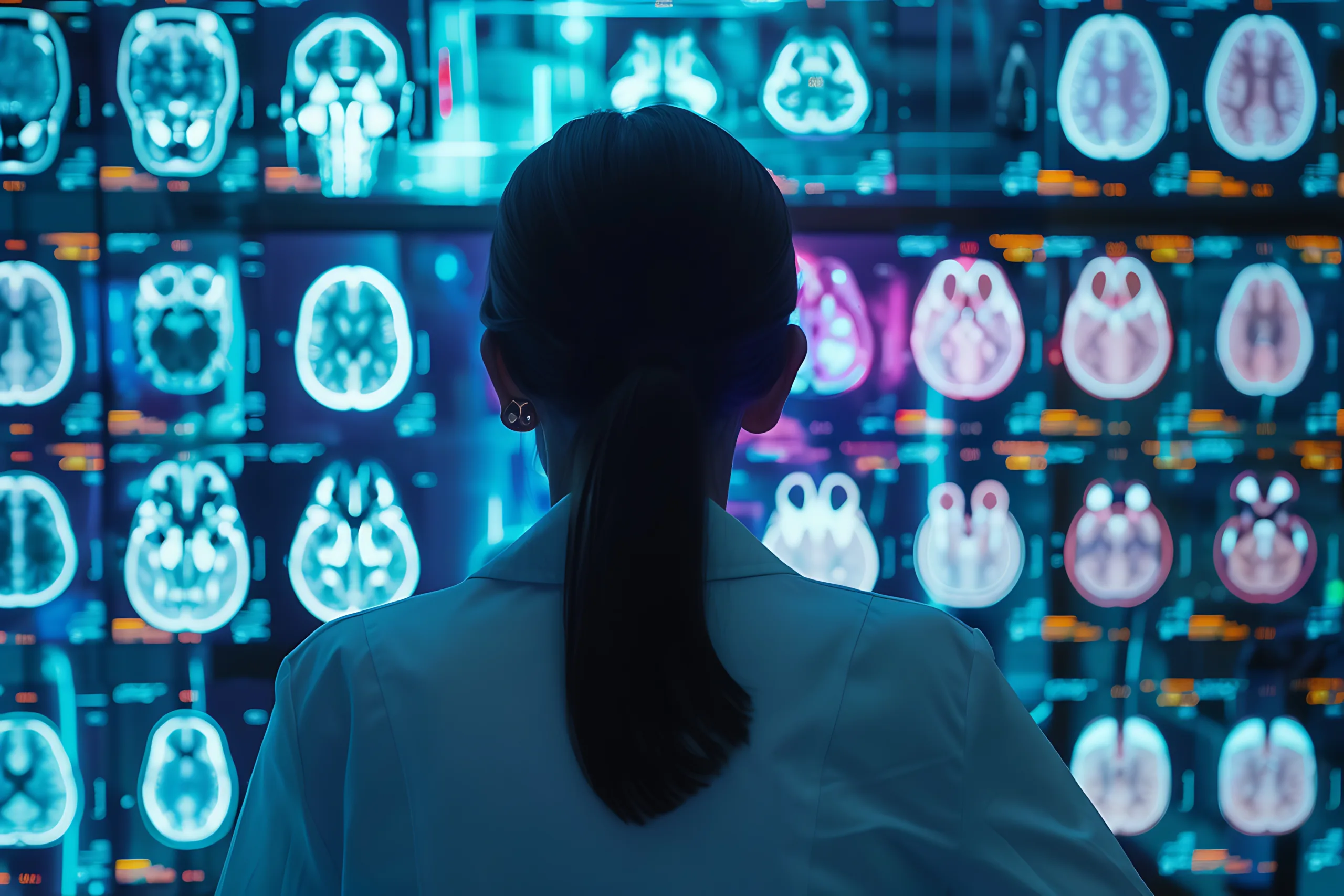Brain tumors are one of the most dangerous medical conditions, with the potential to affect both quality of life and life expectancy. Early and accurate detection is critical to improving the chances of successful treatment. Traditional diagnostic methods, like MRI and CT scans, have served as the standard for identifying brain tumors, but these methods come with limitations. They can be slow, subjective, and prone to human error. This is where Artificial Intelligence (AI) is making a huge impact.
AI-powered tools are revolutionizing brain tumor detection by analyzing medical images faster, more accurately, and with greater precision than ever before. By enhancing the diagnostic process, AI provides doctors with the support they need to make faster and more reliable decisions, ultimately improving patient outcomes.
How Traditional Brain Tumor Detection Works
For decades, brain tumor detection through MRI (Magnetic Resonance Imaging) and CT (Computed Tomography) scans, which create detailed images of the brain’s internal structures. These imaging techniques help doctors identify abnormal growths or signs of cancer. However, interpreting these images can be time-consuming and requires a skilled radiologist to examine them carefully. Unfortunately, even the most experienced radiologists can sometimes miss small, early-stage tumors.
Additionally, interpreting scans can be influenced by fatigue or human bias, making it harder to achieve consistent results. The process often requires a significant amount of time, which leads to delayed diagnoses and treatment. This delay can be critical, especially in the case of aggressive brain tumors, where every day counts.
The Challenges of Manual Brain Tumor Diagnosis
Manual brain tumor diagnosis has several inherent challenges:
- Human error: Even the best-trained radiologists can miss subtle signs of tumors, especially in the early stages when they are harder to detect.
- Time-consuming: The process of manually analyzing brain scans can take hours or even days, slowing down diagnosis and treatment.
- Subjectivity: Different radiologists might interpret the same image differently, leading to inconsistencies in diagnosis.
- Limited resources: Not every hospital or clinic has access to a sufficient number of skilled radiologists, especially in rural areas, leading to delayed diagnoses.
These challenges underline the need for an improved approach that can speed up the detection process, enhance the accuracy of diagnoses, and ultimately help doctors make more informed treatment decisions. AI offers a promising solution to address these challenges effectively.
How AI is Revolutionizing Brain Tumor Detection
Artificial Intelligence is now playing a vital role in transforming how brain tumors are detected. Using AI, doctors can now rely on powerful machine learning algorithms to analyze brain scans far more efficiently. These AI systems are trained on thousands of medical images and use pattern recognition to identify signs of tumors in seconds. Unlike human doctors, AI doesn’t suffer from fatigue or distraction. It remains consistent, ensuring that every scan is analyzed with the same level of accuracy.
AI technology doesn’t just highlight obvious tumors, it can also detect small, early-stage abnormalities that may otherwise be overlooked. This capability significantly improves the chances of early intervention, which is key to better outcomes in treating brain tumors.
Key Benefits of AI-Assisted Brain Tumor Detection
AI-assisted brain tumor detection offers a wide array of benefits:
- Faster Diagnosis: One of the most significant advantages is that AI can process and analyze brain scans in seconds, speeding up the entire diagnostic process. This allows doctors to make quicker decisions and begin treatment much earlier.
- Higher Accuracy: AI systems are trained to recognize even the subtlest patterns associated with tumors, ensuring that diagnoses are more accurate. Studies show that AI can reduce the risk of false positives and false negatives, leading to fewer diagnostic errors.
- Early Detection: Early detection is crucial for successful treatment. AI tools are designed to catch even the smallest and earliest tumors, which increases the likelihood of catching brain tumors in their most treatable stages.
- Reduced Workload: AI can help relieve some of the pressure on radiologists by performing initial scans and analyses. This allows healthcare professionals to focus their attention on more complex cases and make decisions based on AI-generated reports.
These advantages make AI-assisted detection a game-changer in the healthcare industry, offering faster and more reliable outcomes for patients.
AI and Medical Imaging: Enhancing Accuracy & Speed
AI enhances medical imaging by optimizing existing imaging techniques such as MRI and CT scans. These AI-powered tools work by analyzing high-resolution images for signs of abnormalities. The system then highlights areas of concern, allowing the doctor to focus on those areas. This quickens the process and ensures greater accuracy. AI can also compare images from different times to track how a tumor is growing, making it easier to assess the rate of progression.

Since AI is data-driven, it learns from past scans and continually improves its detection capabilities, ensuring that it becomes more precise as it is exposed to more images. This ongoing improvement is crucial in a field where the accuracy of detection can significantly impact survival rates.
Machine Learning in Brain Tumor Detection: How It Works
Machine learning is at the core of AI’s success in brain tumor detection. Here’s a simplified explanation of how it works:
- Training with Data: AI systems are trained on large datasets of brain scans. These datasets include both normal and abnormal scans, allowing the AI to learn what a healthy brain looks like and what tumors might look like.
- Pattern Recognition: AI identifies patterns in images, detecting tiny differences between normal and tumor-affected tissue. These patterns could be in the texture, shape, or size of brain tissues.
- Refining Algorithms: As AI processes more and more images, it continues to refine its algorithms, improving its detection capabilities and reducing errors.
- Diagnosing Tumors: Once trained, the AI can process new scans, highlight areas of concern, and generate a diagnostic report. Radiologists can then verify the AI’s findings, providing a second opinion to ensure accuracy.
By using machine learning, AI can make brain tumor detection faster, more efficient, and incredibly precise.
Early Detection: How AI Improves Patient Outcomes
Early detection is the most significant factor in determining the success of brain tumor treatment. AI’s ability to detect tumors at their earliest stages allows doctors to intervene sooner, leading to more treatment options and a better chance of recovery. Smaller tumors are easier to treat, and early treatment often leads to better survival rates.
AI’s speed and accuracy enable doctors to start the treatment process much faster, reducing the time between diagnosis and intervention. This not only improves patient outcomes, but also lowers the overall cost of treatment by addressing tumors before they become advanced and harder to treat.
Real-World Applications of AI in Brain Tumor Diagnosis
AI is already being used in hospitals, medical centers, and research labs worldwide. Some notable examples include:
- Google DeepMind AI: This AI system has shown the ability to detect brain tumors with exceptional accuracy, even in complex cases.
- IBM Watson Health: IBM’s Watson is being utilized to analyze medical data and provide treatment suggestions, including tumor detection.
- Microsoft InnerEye: This tool helps radiologists by automatically identifying and segmenting tumors in medical images, making diagnoses faster.
These real-world applications demonstrate how AI is already making brain tumor detection more efficient and effective in clinical settings.
Limitations and Ethical Concerns of AI in Healthcare
Despite its advantages, AI in healthcare does come with challenges and limitations:
- Data Bias: AI algorithms are only as good as the data they are trained on. If the training data is not diverse enough, the AI might not perform well for certain populations.
- Over-reliance on AI: While AI is powerful, it should be used as a tool to assist, not replace, human doctors. Relying too heavily on AI could lead to a loss of human expertise.
- Privacy Issues: Handling sensitive patient data requires strict privacy protections to ensure that AI systems don’t compromise data security.
- Regulatory Hurdles: For AI to be used in clinical settings, it must meet medical regulatory standards, which can be a lengthy and complex process.
While AI has enormous potential, it must be integrated responsibly to address these concerns.
The Future of AI in Brain Tumor Detection
The future of AI in brain tumor detection is bright. As AI technology continues to advance, we can expect even smarter models that can:
- Predict tumor growth and suggest personalized treatment options for patients.
- Provide 3D visualizations of tumors, improving surgical planning and treatment precision.
- Integrate with wearable devices, providing real-time monitoring of brain health and early warning systems.
As AI continues to evolve, it will make brain tumor detection faster, more precise, and increasingly accessible to people all over the world.
Why AI is a Game-Changer in Tumor Detection
AI has revolutionized brain tumor detection by making it faster, more accurate, and more accessible. By improving the speed of diagnosis, enhancing accuracy, and enabling early intervention, AI is helping save lives. As this technology continues to advance, it will play a critical role in the future of brain tumor detection and treatment, improving patient outcomes globally.
With AI, the world of medical imaging is transforming, and the future looks brighter than ever for early detection and successful treatment of brain tumors.

